"This was one of the best things that
I have ever seen. How can I find other theater plays like this one?"
IN APRIL OF 2023 MY PARTNER ASKED ME THIS QUESTION, AND THIS WAS THE BEGINNING OF MY FIRST UX/UI PROJECT.
NAME: Sampa Teatro APP
PROJECT: An app to search plays in the city of São Paulo and to connect a community that is interested in theater
TOOLS USED: Notion, Form-Tally, Figma - FigJam, Adobe XD, Illustrator

THE PROBLEM
I took my partner to see this play in São Paulo: "Enquanto você voava, eu criava raízes", which translates into English: "While you were flying, I was putting down roots." It's a fantastic production by Cie Dos à Deux, that works with physical theater. This unique piece was being presented at Sesc, with a very low cost ticket prices, despite this, the audience seemed to be mostly people from the creative arts community.
After the performance, my partner was surprised and asked me how to stay informed about such productions, to which I replied that I followed that theater company on Instagram. However, he expressed a desire to have easy access to information about all the plays in São Paulo, not just the well-known ones.
I was aware that this is a big challenge in the city, where various factors contribute to the difficulty companies face in reaching audiences and filling theater seats. Although I knew some methods for staying updated on theater events in São Paulo, I began to question if I just had this knowledge because I'm involved with the theater industry.
At that moment, I was starting my studies in the UX area and decided that this would be my first UX project.
START OF THE PROJECT
THE DESK RESEARCH
OBJECTIVE - Understand audience attendance at cultural activities, especially theater plays, in Brazil focusing on São Paulo
The main source of my Desk Research was one survey conducted by Datafolha in August 2022, in partnership with Itaú Cultural, which revealed cultural habits of brazilians. The research brought alarming numbers regarding the reduction of cultural activities post-pandemic:
62%
said they participate in cultural activities less frequently than before COVID-19
26%
said cinema would be the main activity - however, this is less than half of the 59% who attended movie screenings before the pandemic.
18%
of people attended music festivals, artistic or dance performances, or theater, compared to 38% before the spread of the disease.
Despite this, 48% of the interviewees believed that culture and leisure activities can contribute to improving quality of life, reducing stress and anxiety, as well as alleviating loneliness.
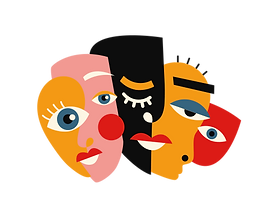
The research also revealed interesting facts: 55% of the interviewees said that they keep informed about cultural events through social medias, while 35% rely on recommendations from friends or relatives - indicating that word-of-mouth remains a powerful tool for promoting theater.
Another major source of my research was the debate, also promoted by Folha and Itaú Cultural, which brought together prominent figures from the theater industry, critics, cultural journalists, as well as influencers, podcasters, and YouTubers in cultural activities.
During the debate, there were very interesting declarations that mentioned things like:
The difficulty for theater to compete with the multiples leisure activities that the modern world has brought, and how to make theater as attractive as them.
The challenge of making going to a theater a habit, especially in a society that now has so little free time.
Today, the audience wants to be somehow part of it all: participate, express opinions, interact.
How to make that person
feels that they are part of a
theater community?
With the results I built the CSD Matrix of the project, and the doubts conducted me to the next step of the project.

CSD Matrix.
TALKING TO THE PUBLIC
OBJECTIVE - Understand how the public searches for theater plays in São Paulo, which public searches for this type of entertainment and how frequently.
I opened the second part of my project with the cruel understanding that the spectator frequency was already low, but these numbers worsened after the pandemic and the options to compete with theaters had increased.
I already had some pre-formulated hypotheses about the low attendance of paulistanos at theater plays in the capital due to my experience in the area. Such as:
I believe that people don't go to the theater often because they don't know where they can search for the plays.
I believe that the promotion of certain types of plays only comes to the attention of people who already work in theater and does not reach the general public.
The Desk Research has shown me other hypotheses that contribute to these low numbers, such as:
The lack of habit and the difficulty for the audience to feel like they belong to the theater product, when they do not work directly in the area.
With this in mind, it was time to listen directly to the public and understand the users’ needs. I created a form with 28 questions divided into four segments:
1 - Demographic Information
2- Cultural Habits and Means of Entertainment
3- Opinions and Preferences
4- Final considerations
I obtained 89 responses, being reached mostly by:

women, 65,5%

completed graduation education, 48,3%

residents of the south and west zones in
São Paulo

with a salary
range above
11 minimum wages, 41,4%
THE MAJORITY WERE ALSO NOT WORKERS IN THE AREA OF CULTURE OR TAKING ANY COURSE IN THE AREA -
The research results showed that the majority don't go to theater, and the main factors behind lack of frequency are:

Not knowing where to find information

Competition with other plans
Never having created the habit
The difficulty in finding friends to tag along
With these answers, it was possible to take the next step of the project: the development of personas.

The charts of the user research result.
BUILDING THE PROTO PERSONAS
For the personas creation, I prioritized simplicity and direct information, focusing on the objectives and needs of each one. There were some common points in the answers from the user research, as well as a final field for additional and individual comments in the form, which allowed me to separate them into 4 distinct groups and create 4 proto personas*:
*The statements highlighted below in each of the personas were phrases actually received by interviewees.

"I think it's important to better promote smaller and medium-sized plays because most of the promotion is always for big productions. So, the cycle continues: the same people watching the same things."
Débora - 33 years old - Language teacher,
Doesn't know where to search for theater, understands that ticketing apps only have registered events and doesn't know a digital product that centralizes all theater plays information in São Paulo.
Needs:
• Access to see information in one place
• Objective search filters
• Clarity on prices with easy redirection link to buy tickets

"Often, the proximity of the theater to a subway station, the level of security of the location, and the schedule/duration of the performances influence whether to attend the play or not."
Aline - 27 years old - Marketing professional,
Likes theater, but often skips going due to the location and schedule of the play, finds theater locations unsafe and lacks company to accompany her to public transportation.
Needs:
• Quick access to play location information - if it is close to her home
• Quick access to play duration - if is compatible with public transportation schedule
• Company for public transportation

"I feel that theater themes follow two extremes, either too silly (comedy) or trying to be too conceptual and end up being pretentious. There's a lack of a middle ground."
Rosana - 54 years old - Lawyer
Believes that theater only has 2 patterns and doesn't have much time to search for information, so she always opts for musicals as she finds it to be a safer choice.
Needs:
• Quick access to show information such as the play genre
• Easy access to the reviews by spectators

"I love theater and want to attend more often. But I have difficulty making plans alone and can't find company for these events."
Igor - 20 years old - Engineering student
Likes and is interested in theater, but says he doesn't like going to plays alone and has difficulty finding company with the same interest.
Needs:
• Connection feature for a community interested in attending plays and being able to schedule meetups for these events.
THE USER FLOW AND THE WIREFRAME
In the user flow development, followed by the wireframe, some points of attention for the digital product, resulting from user research, were essential:
audience reviews
A review or recommendation from a friend is the number one reason why audiences chose one play over another. Considering that most interviewees said they had already posted a positive review of a play on social media, and knowing that today users connect much more with real audience opinions rather than specialized critics, a highlight in the presentation of the theater plays will be a scoring system that is based on the evaluations of the users.
onboarding with the play gender choice
Understanding that the genre of the play was the second most voted reason when the user chooses a play, this will also be a highlight point and easily reachable in the app, which will also be a tool on the onboarding for the user to make their genre preference choices. Thus, as the main section of the application, the user can access the "For You" section which brings plays related to their personal choices.
near you
To meet the need for quick access to the location of the shows, the app also features a map system linked to your location, which shows the closest plays to where you are.
theater community
And finally, considering the problem pointed out by professionals in the field who believe there is a need to bring the audience closer to the theater product, and the widely pointed out issue in the research as the lack of company for the program, the application will have an exclusive service to bring together the theater-interested community. In the "Find Company" section, it will be possible to create an event, proposing a meeting of people with the same interest to attend a specific play. An important point in creating this tool is that the application does not intend to promote romantic dates, so the chat, for those involved to communicate with each other about the event, is only opened when 2 or more people express interest in the meeting.
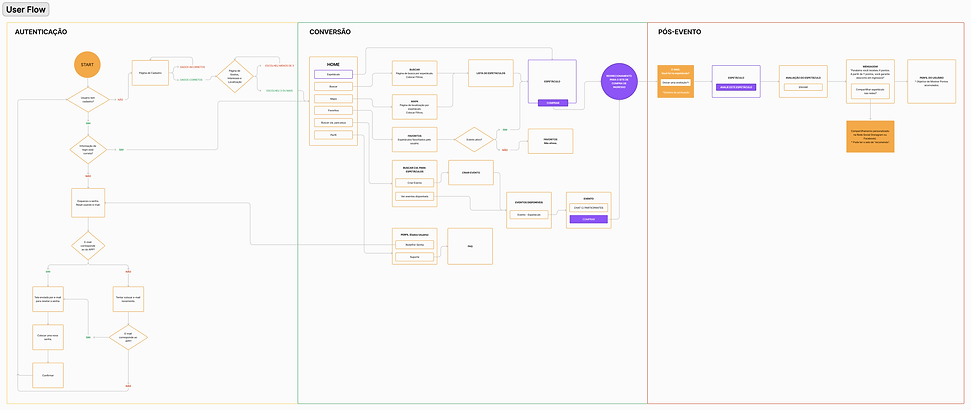
The userflow.

The wireframe.
THE APP - THE FINAL SCREENS AND THE LAST INSIGHTS
For the visual language creation for the app, the following Moodboard was developed, bringing elements from the theater, but especially from São Paulo, as it is a tool specifically for the capital city.
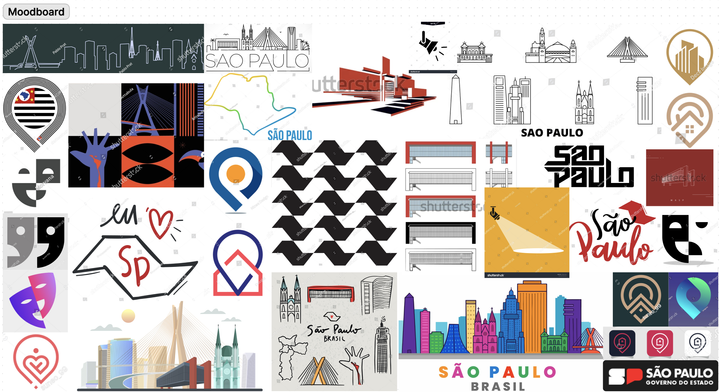
The moodboard.
Analyzing the moodboard allowed us to highlight the straight lines, the simple, but huge architecture, the use of primary colors such as red and yellow, with black also appearing as a very frequent color, and the modern, imposing design of the big city.
Therefore, the visual principles created by the Bauhaus school served as the starting point and reference for the development of the logo, as well as the entire visual app language. Theatrical elements such as stage lighting and commonly used sentences in the field, such as "Third call! The play is about to begin!"were also common choices in building the application, focusing on immersing the user in the theatrical environment.
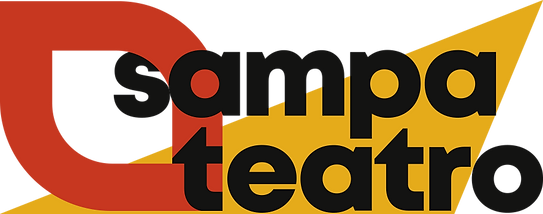

The app features a theater play finder right on the home screen, followed by sections:
• For You,
• Upcoming Premieres,
• Recently Viewed,
• Top Ratings.
You can also easily find the plays's score on the main card on the home screen.

You can also find the ratings with comments on the screen with complete information about the play.
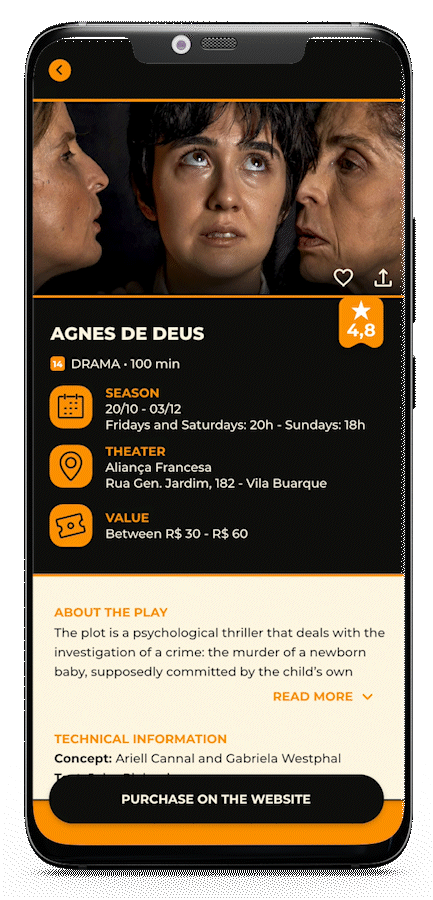
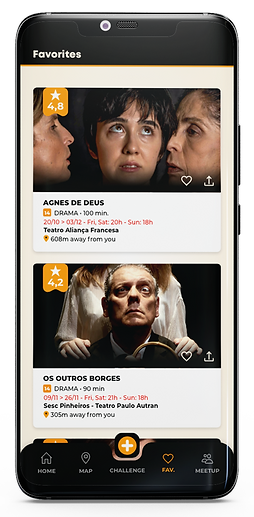
The main menu includes the Favorites section, which displays all shows favorited by the user, as well as a Map Search, to find the bests plays right next to the user.
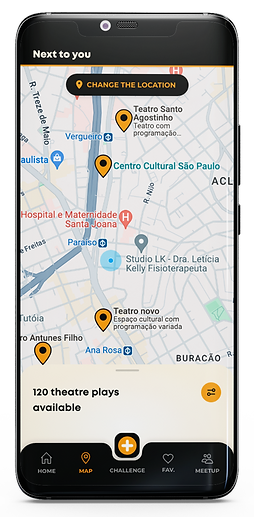
To resolve the problem widely reported in the user interview, about the lack of company to go to the theater - and also thinking about the issue raised by artists that it was necessary to create a community interested in theater - the app offers a "Meetup" tool.
Through it, users can view available meetings, express interest, or "Create a Meetup". Using the search function, they can find the play, select the date, and time for the meetup.
An important note is that the app will suggest that meetings be scheduled at the theater itself, such as in the cafeteria or at the box office. Once the meeting is created, the user will receive a notification when 2 or more people express interest, and the communication chat between the involved parties will be opened.
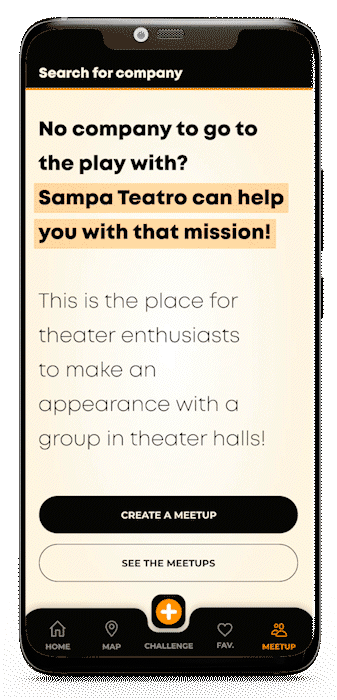
One crucial aspect was still missing:
addressing the central issue of the lack of audience in theaters in São Paulo, which had been highlighted since the Desk Research phase, as well as in the User Research, was the user's lack of HABIT of going the theater.
As we have seen throughout the research, there are several factors contributing to this problem.
But how could Sampa Teatro contribute to improving this issue, besides the previously considered facilitations?
The first solution that crossed my mind was to offer progressive discounts based on app usage. However, this solution would clash with other issues, such as:
• The app is not a sales platform, it just redirects users to the shopping sites, and discounts would need to be negotiated with third parts.
• One of the central problems for small companies in promoting their plays is precisely the lack of funds in production, which makes investing in press agencies unfeasible.
• The price of the play appeared in the user research only as the fourth factor to consider when choosing a play, suggesting that it might not be the central point for the lack of audience habit.
Returning to the user research, it was possible to verify that:
53%
of interviewers rated with a score of 5 (maximum score) that they believe cultural activities reduce anxiety, stress, and loneliness. Another 21% rated it with a score of 4.
84%
believe that cultural activities provide moments of relaxation and leisure.
74%
said they promote reflection and self-awareness.
With this analysis, behavior gamification was introduced in the app.
By showing users the benefits that increased theater attendance can bring to their lives, the app proposes a "Cultural Challenge!".
The user will set their own monthly goal and can earn "Galharufas"* to achieve it.
"Checking in at the theater" will earn them 5 Galharufas, "writing a review of a play" will earn 4 Galharufas, and "scheduling a meeting through the app" will earn 3 Galharufas. The user's performance will be displayed on the home screen so that they can easily monitor their development.
"Galharufa" is an object that rather a special symbol granted to beginner actors. Besides representing a performance talisman, it's the director's way of wishing "good luck" to the artists - the theatrical equivalent of the popular "break a leg!".
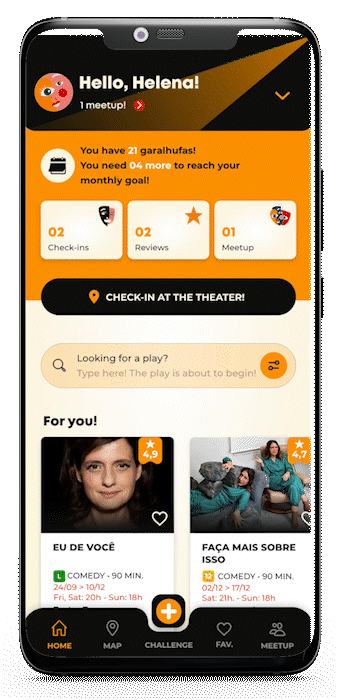
And to encourage the user to continue on the challenge journey, the app will provide motivational notes, elucidating the improvements that this frequency brings to their lives.

The user will receive medals upon achieving their goals, and the app will provide funny and stimulating titles for the user, every month they complete the challenge!
- Theater Titan
- Drama Diva/Divo
- Stage Star
- Curtain Crusader
- Performance Prodigy
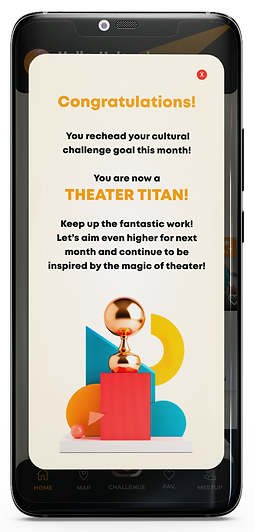
CONCLUSION
Upon starting this project, I was certain that the answer would be the creation of a digital product capable of unifying all communication and promotion of plays in São Paulo, considering that the main source of information is still a magazine, comprehensive, but little known to the non-theatrical public.
However, throughout my journey, I realized that the offered product should provide many other tools to address the central issue of lack of audience. Therefore, Sampa Teatro has the objective not only to provide ease of theater play search to the user but also to bring theater companies closer to their audience and provide a quality service to the artists of the capital for the promotion of their works, which involve so many people, sweat and dedication.

